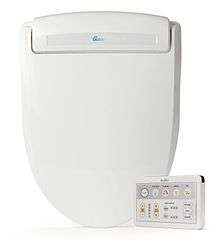Electronic bidet

An electronic bidet is a nozzle attached to an existing toilet, or a part of the toilet itself. In this case, its use is restricted to cleaning the anus and genitals. Some bidets of this type have the one nozzle on the side rim for anus and genital areas, or two nozzles on the back rim. The shorter one, called the "family nozzle", is used for washing the area around the anus, and the longer one ("bidet nozzle") is designed for women to wash their vulvas.
Features
The most basic feature is the nozzle that comes out from underneath the toilet seat and squirts water. It has two settings: rear cleaning to wash the anus, and feminine cleaning to wash the vulva. The nozzle is also self-cleaning and cleans itself before and after operation.
Other features:
- The seat-heating feature is very common, found even on toilets that lack the bidet features. In Japan, most homes lack central heating, instead using space heating; the bathroom may be only a few degrees above freezing in the winter.
- Most modern electronic bidets include customization options to match the user's preferences. Such options include adjustable water, air and seat temperature, adjustable water pressure, and adjustable nozzle direction.
- Some toilet seats include built-in deodorizers and activated carbon filters to remove odors.
- The massage mode usually refers to either the "oscillating mode," in which the nozzle moves back and forth quickly while spraying water, or the "pulsating mode" which varies jet intensity to help stimulate bowel movement.
- Other popular features include wireless remote control, energy saving mode (which activates the heating only if it senses the user sitting on the toilet seat), and automatic opening and closing of the lid.
History
1960s: Early years
In the early 1960s, Arnold Cohen's father had a medical condition that caused pain in the rectal area, and Arnold wanted to make his life easier. After two years, he completed the design of the first toilet seat bidet system, which featured a nozzle that sprayed warm water and blew hot air behind his father. In 1964, Arnold patented his design, founded the American Bidet Company, and started marketing the innovative bidet product, dubbed "American Sitzbath", by using large ads and attending trade shows. The product was aimed for use at hospitals for patients who had difficulty using toilet paper or reaching around to wipe themselves. Arnold installed thousands of these seats all over the suburbs of New York, and the company had offices all across the country, but due to cultural barriers, advertising was almost impossible and few wanted to run the ads that the company produced.[1]
Following the failure of the product in North America, Arnold licensed his invention and patent to the TOTO company in Japan. In 1967, TOTO imported Arnold's bidet system, now rebranded as 'Wash Air Seat' in Japan. The bidet system failed in Japan as well, because it was too expensive and the bidet function was too foreign for Japanese consumers.[2]
1980s: Introduction of the Washlet
In 1980, TOTO introduced the Washlet G, which debuted with three functions: rear cleansing, dryer, and a heated seat.[3] In 1982, the first Washlet television commercial aired, featuring the singer Jun Togawa telling viewers that 'even though it's a bottom, it wants to be washed too'. In another ad, she was shown standing on a fake buttock reading a letter supposedly from her bottom, which writes that 'even bottoms have feelings'.[4]
The Wash Air Seat and the early Washlet operated mechanically, and it took several minutes for the spray to spray and for the water to heat. These problems were solved by making the workings electronically operated, the spray instant, and the angle perfect. The Washlet's nozzle was made to extend and retract at exactly 43 degrees, a position precisely calibrated to prevent any cleansing water from falling back on the nozzle after doing its job (This is known as "backwash").
Two TOTO engineers, Mr. Kawakami and Mr. Ito calculated the average location of the human anus with the aid of 300 colleagues who were persuaded to sit on a toilet in private and to mark the positions of their anuses by fixing a small piece of a paper to a wire strung across the seat. The average location of the female vulva was measured in a strip club.[4]
In 1987, TOTO launched the first integrated Washlet.
1990s: Widespread adoption
In 1992, TOTO launched the Neorest, a tank-less toilet with an integrated Washlet.
In popular culture
Electronic bidets have been featured in the Simpsons and Futurama as "Japanese Toilets".[5]
See also
References
- ↑ "Arnold Cohen, Bidet King Extraordinaire - Bidet.org". www.bidet.org.
- ↑
- ↑ "The history of TOTO WASHLET: TOTO Washlet". washlet.totousa.com.
- 1 2 George, Rose (30 August 2008). "Japan's hi-tech toilets" – via www.telegraph.co.uk.
- ↑ "The Japanese Toilet Seat Guide: A British Perspective". Washloo.